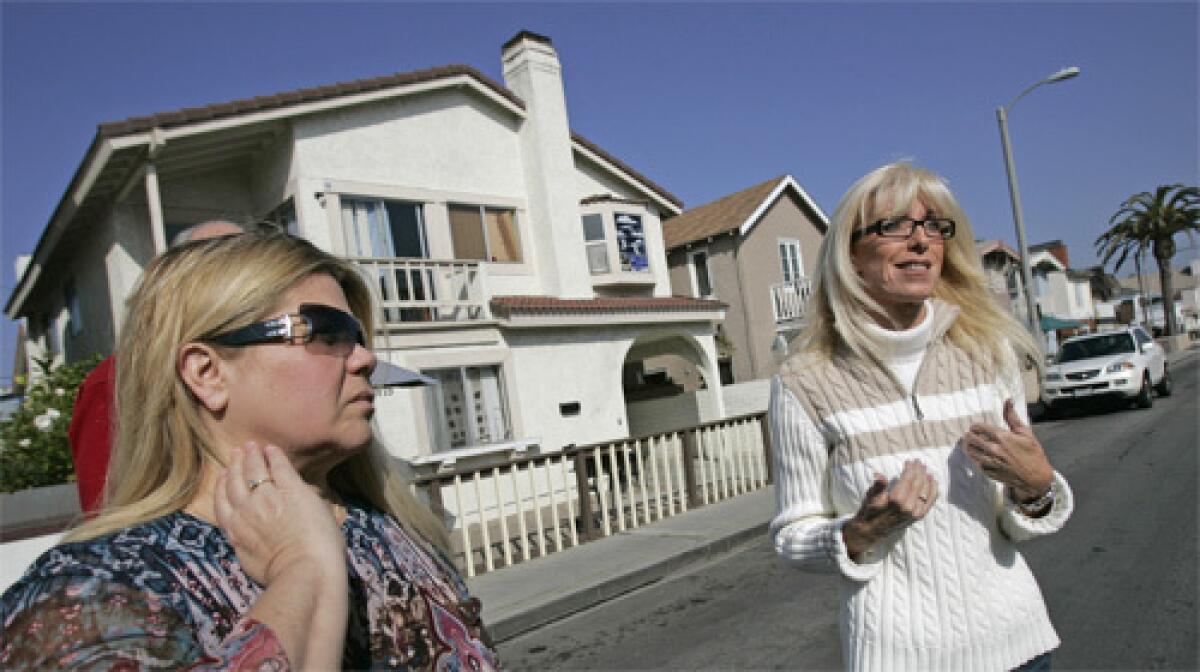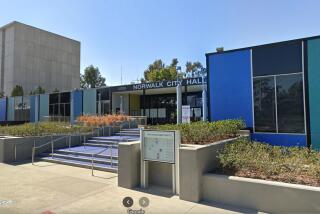It’s surf, sun, sand and -- sobriety?

The company’s brochure features an aerial shot of the Balboa Peninsula and describes its 90-day drug and alcohol recovery program as “located in the warm, healing climate of Southern California.”
It’s that kind of promise -- in this case from Sober Living by the Sea -- that has made Newport Beach an unlikely capital for drug- and alcohol-free homes. There are at least 76 such facilities in Newport, according to a city survey, a number that has rocked sensibilities in a town where a premium is put on fun, sun and the good life.
“There has been an institutionalization of our streets and a taking of our neighborhoods that does not serve the residents or the addicts, only the for-profit operators,” said Cindy Koller, a member of Concerned Citizens of Newport Beach, a group formed to fight the proliferation. She and other community activists say the heavy concentration of sober-living group homes, where recovering drug and alcohol users live several months at a time, has turned their neighborhoods into quasi-hospitals.
Tonight, the City Council is expected to pass one of California’s most extensive ordinances regulating sober-living homes. Operators of the homes have threatened to go to court to block the law. The debate here is being watched closely by communities up and down the coast as a test of how far local governments can go in reining in a largely unregulated cottage industry.
Newport’s fight mirrors tensions in beach cities throughout California. In 2000, San Clemente residents pushed with little success for state legislators to regulate sober-living homes. A few years earlier, San Pedro tried to limit “special needs” homes, which include sober-living facilities, without success.
Residents of Malibu, famed for its high-end rehab centers catering to the rich and famous, have begun to mobilize against the recovery homes popping up in their canyon neighborhoods. The homes number at least two dozen, city officials said.
“It’s this daisy-chain effect that we’re concerned about,” said Malibu Mayor Jeff Jennings. “At some point, instead of living in a residential neighborhood you begin to live in something like a hospital zone.”
Newport’s ordinance would require unlicensed group homes of any size to apply for city permits. It would also subject unlicensed homes that share staff -- so-called integral facilities -- to city regulation. New group homes would be limited to areas zoned for multi-family residences -- about 1,000 acres of the city. Some activists insist that the city go further, but city lawyers say additional restrictions could be discriminatory.
Critics say the owners of the homes, mostly for-profit companies, market themselves to recovering substance-abusers who pay tens of thousands of dollars to attend rehabilitation programs in a beach town.
“These are businesses that are being operated in residential neighborhoods,” said Lori Morris, an activist with Concerned Citizens of Newport Beach. “It’s not the rehab homes we’re against; it’s the over-concentration.” The bulk of the facilities in Newport are in two pockets on the Balboa Peninsula.
Opponents of the homes also argue that the peninsula -- home to about 11,000 people and swelling seasonally with vacationers and college students -- is the wrong place for rehabilitation facilities. The peninsula is known for its night life and raucous Fourth of July partying. According to Newport Beach police, 75 establishments sell liquor in the 2-square-mile strip.
“Why do they send rehab kids to the worst place to stay sober other than Tijuana?” wondered resident Ken Kuhlman, a retired salesman.
Sober-living providers say they are offering a much-needed public service and call Newport’s proposed ordinance illegal and discriminatory.
Their patients are not the cursing, incessantly smoking nuisances neighbors make them out to be, said John Peloquin, a vice president of operations for CRC Health, the company that owns Sober Living by the Sea, the city’s largest provider of recovery homes.
“They’ve portrayed our homes as nothing but flophouses,” said Bill Swiney, Sober Living by the Sea’s executive director. “These are professionally run, tranquil and peaceful facilities.”
Swiney said his programs aim to give a realistic experience of life without chemical dependency, and that Newport is as good a location as any.
“We can’t hide them behind the oleanders of Betty Ford [Center] any longer,” he said. “We’re trying to give them a support system so they can live in any environment. We want them to be able to walk right by the bars.”
Newport Beach’s 76 sober-living homes provide more than 500 beds, according to a survey done by Assistant City Manager Dave Kiff. Only 28 of the facilities are licensed by the state. The survey showed that Newport Beach has four times the number of licensed sober-living homes than it would have if they were distributed evenly per capita statewide.
The California Department of Alcohol and Drug Programs requires licenses only for homes that provide treatment on-site. Since many sober-living homes merely offer an alcohol- and drug-free environment, they are not licensed.
Cities may regulate group homes only if they have more than six residents. Under state and federal law, homes with six or fewer people must be treated like any other residence and are not subject to local control.
It’s that lack of regulation, critics say, that has allowed the homes to spread through the city unchecked. The operators can lease multiple homes, house fewer than seven patients in each, then treat them off-site at a central facility.
The group homes are also moneymakers for the homeowners who lease to them. Because the operators can rent to as many as six people in each dwelling and charge a premium, renting to them is more lucrative than renting to vacationers, college students or families.
There’s little doubt that Newport Beach will be sued if the council approves the regulations. Sober Living by the Sea plans to file suit once the ordinance passes, as does Concerned Citizens of Newport Beach if the city’s ordinance lacks the teeth to substantially limit the group homes.
The state attorney general’s office said in an opinion issued last month that neither state nor local government has the authority to limit substance-abuse treatment facilities, even if the community has more than enough to meet the local need. The opinion came at the request of state Sen. Tom Harman (R-Huntington Beach), who made a failed attempt this month to give cities more rights to regulate recovery homes.
Backers of Newport’s ordinance, however, contend that the city is being unfairly burdened. Newport has the highest number per capita of sober-living facilities in the state, they say, although no comprehensive statewide statistics exist. The state keeps track of only the 910 licensed residential programs, which have a total bed capacity of 21,000.
Michael Cunningham, chief deputy director of the Department of Alcohol and Drug Programs, said California does not want a limit on recovery facilities. “We actually need more treatment facilities in the state, not less,” he said.
Cunningham said he didn’t believe there was an over-concentration of such homes along the coast -- though no such statistics are kept -- but acknowledged that that was where most complaints had come from.
The anticipated legal fight has turned cities throughout the state into avid spectators, said Laguna Beach City Manager Ken Frank.
“We definitely have group homes in residential neighborhoods; we definitely get complaints about it, and we definitely can’t do anything about it,” he said. “As you might suspect, we’ll be watching this.”
More to Read
Sign up for Essential California
The most important California stories and recommendations in your inbox every morning.
You may occasionally receive promotional content from the Los Angeles Times.











